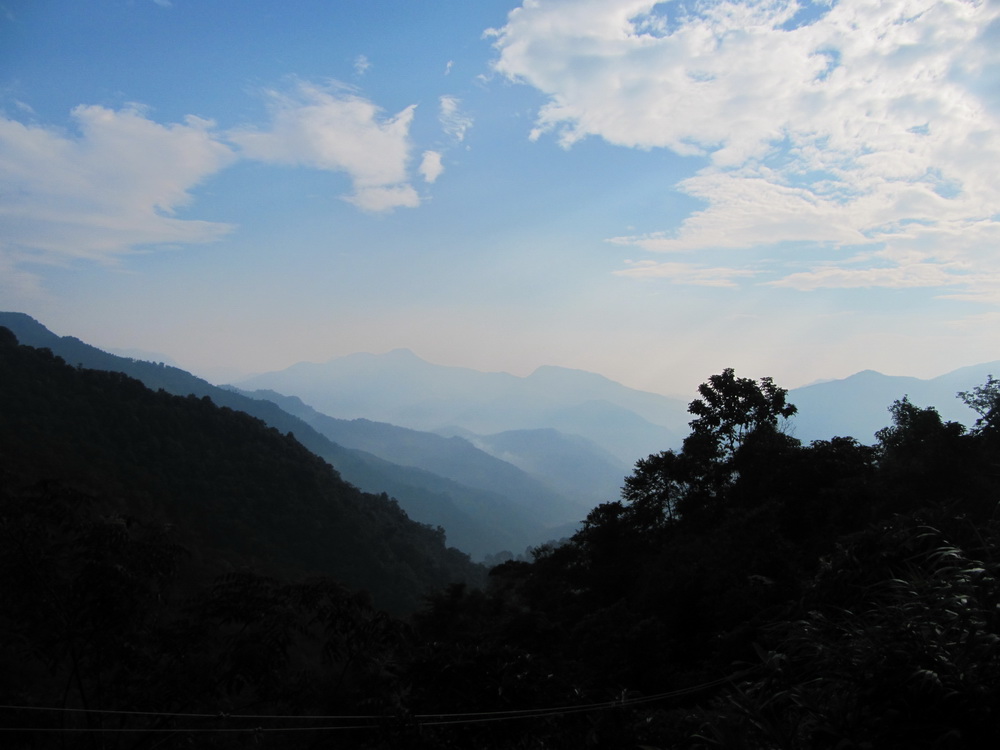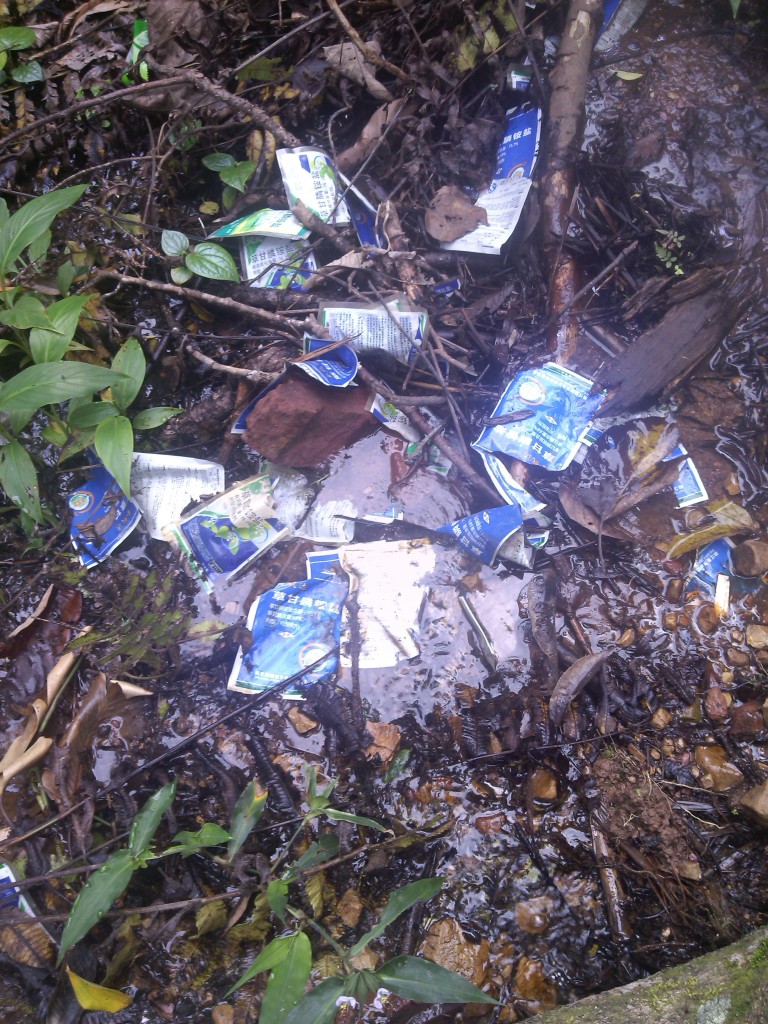After writing this post, I deliberated for some time on whether to post it or not. It’s not such happy reading, but in the end I’ve decided to go ahead. With ‘Publish and be damned!’ ringing in my ears, here it is:
“It stays in the soil for fifty years” he declared, which sounded a little implausible given that Glyphosate was invented in 1970 and has been commercially available less time than that. But it’s possible.
It was the tail end of summer and I was on a few days trip near the Lao border, going up the county road which runs from Meng Xing up to Jiang Cheng, and heading off into the mountains on the east side: Tong Qing He, Bai Sha He, Bai Cha Yuan, Wan Gong, Yang Jia Zhai, Yi Shan Mo, Zhang Jia Wan, Jiu Miao, and so on – and had bumped into a tea lao ban on the road. We were discussing the use of Glyphosate, or cao gan lin.
At the other end of the spectrum is the kind of hyperbole Monsanto pedals, even in the face of almost overwhelming research to the contrary, insisting that Roundup is as safe as mothers’ milk, or words to that effect. “Roundup.. agricultural herbicides continue to be a perfect fit with the vision of sustainable agriculture and environmental protection.” they say. That’s some pretty tall cotton too.
The feaces really hit the fan in 2000 when the patent expired: Monsanto dropped the price in order to stave off competition and there was a consummately large increase in sales although truth be told, Cao Gan Lin was widely available in China much earlier than that, made under license or not. (Recently the government has made attempts to reduce the huge over-supply of Chinese Glyphosate.)
Touted as ‘the most widely used herbicide in the world’ its use is extremely pervasive and has wide implications for users and consumers. I have no need to catalogue the research, one just has to search online, or if you can’t be bothered with that, click on some of the links at the bottom of the post.
Not surprisingly, there are few tea farmers with old tree gardens who will readily admit to using it. Some will acknowledge that they used it in the past, but not anymore. Unfortunately, evidence of it is quite widespread.
As Tea Urchin commented some time back, the presence of spraying equipment doesn’t have to sound the death knell, but when it’s in remote tea fields, unless they happen to have been growing some corn or something nearby, there’s not really any other reason they would have had the equipment there.
I was exploring some areas off the S218. One day, we had been walking in forest for an hour or so, crossing a stream in our path, we saw this:
If you can’t see clearly enough in the photo, it’s bags of Glyphosate.
Where there is a ready supply of water, this is a relatively easy method of clearing weeds. In this case it was done in a cleared forest area in order to plant some tea seedlings, so this does not necessarily mean that old tea trees are being treated the in the same way, but it is unfortunate evidence to come across in what should be pristine forest.
Most tea farmers have now have got strimmers to keep the weeds down, but it’s hard work and needs to be done two, or even three times a year to keep the weeds at bay. So it shouldn’t be a surprise that even in areas where farmers have to go by motorbike and on foot for up to a couple of hours to get to their tea gardens it’s not sure to be trouble free. It’s fairly common, in the small gazebos that most farmers have in their tea fields, to find spraying equipment.
I’m trying to resist being drawn to the conclusion that the more remote the area, the more likely the tea farmers are to have used chemicals on their tea gardens, but there are reasons why that could be the case.
Lao Feng (Mr Feng to you) once said to me you only had to look at all the queues of farmers waiting in hospitals to realise how widespread the use of agro-chemicals was and how injurious the effect.
It’s not that simple: farmers now all have health insurance, and western medicine particularly seems to be viewed as a panacea. (It’s common for people to go to a hospital or clinic for intravenous drug treatment for such things as a common cold.) So the preponderance of country folks in city hospitals cannot be construed necessarily as an indicator of their poor health, triggered by profligate or irresponsible agro-chemical use.
Having said that, the concerns are legitimate and I know people who believe that drinking water in rural areas is often affected to the extent that one could not sample tea in a village using their own water and be clear about whether any chemicals present were from the tea or the water, or both.
A Zhang Jia Wan tea farmer said to me a while back, “In 2005 we all used it, then we realised it was not good and haven’t used it since.” But it’s anecdotal. It’s not ‘everyone’. It’s a pointer that when sourcing tea one must be ever vigilant, and looking can only tell you so much.
The half life of Glyphosate in soil varies and is said to be as short as a few days and as long as half a year. What that means is that it could be ‘gone’ in a few months or there could still be small amounts in the soil a few years later. Residue in the plant is another issue.
Tea shop lore is that the year it is sprayed (typically in the winter months), Roundup may not be that obvious in tea, and is most noticeable in crops two years later, from when on it diminishes.
More recent research has shown that some of the so called inactive ingredients in Roundup are also harmful, meaning that the mix of chemicals is potentially more harmful than Glyphosate alone. (see links below)
So what to do about it?
For a couple of thousand yuan you can go to the government quality assurance office (zhi liang jian du ju) and give them a kilo of tea that they will test for all manner of things: DDT, Bifenthrin, Chlorpyrifos and so on, along with caffeine, theine, etc. But no Glyphosate. I once asked them at the local offices why. ‘Because cao gan lin is not on our list of permitted agro-chemicals’ they said.
It’s a fine logic – why would you bother to test for something that was not permitted? What’s much more bothersome is that if you check with all the big testing companies present in Asia (mostly western), none of them routinely test for Glyphosate as any part of their standard testing packages. It can be done, but you pay for it. It would be tempting to begin to see it as some kind of wider issue that a conspiracy theorist might have fun with, but a more measured view is that there is no straightforward, affordable methodology for testing for it.
So testing is not much of a solution. One has to rely on ones own accumen to detect it. The indicators have been well catalogued: tingling on the tip of the tongue or inner lips, or sometimes a slight numbing, puffy feeling, a prickly, dry feeling in the throat, and so on. Whether any and all of these are attributable to Glyphosate is a moot point. There could be many reasons a tea can produce these kind of sensations, and not all chemical, but it is a warning sign to be heeded.
http://www.reuters.com/article/2013/04/25/roundup-health-study-idUSL2N0DC22F20130425
http://articles.mercola.com/sites/articles/archive/2013/07/30/glyphosate-toxicity.aspx
http://articles.mercola.com/sites/articles/archive/2012/10/23/glyphosate-found-in-human-urine.aspx
http://www.i-sis.org.uk/Why_Glyphosate_Should_be_Banned.php
http://www.pan-uk.org/pestnews/Actives/glyphosa.htm
http://en.wikipedia.org/wiki/Glyphosate
http://www.sourcewatch.org/index.php/Glyphosate
http://www.frost.com/prod/servlet/market-insight-print.pag?docid=JEVS-5N2CZG
http://www.beyondpesticides.org/infoservices/pesticidefactsheets/toxic/glyphosate.php
http://www.scientificamerican.com/article.cfm?id=weed-whacking-herbicide-p


